Procurement Systems in Construction: A Detailed Report
VerifiedAdded on 2022/09/08
|17
|4299
|43
Report
AI Summary
This report examines strategic construction procurement, focusing on various methods to assist public sector clients in selecting suitable procurement systems. It provides a detailed explanation of traditional, contracting, design and build, and joint venture procurement methods, including definitions, key characteristics, and the implementation process. The report highlights contractual and functional relationships and offers a comparative analysis of each method, outlining their respective advantages and disadvantages. The document delves into the merits and demerits of each procurement approach, providing a comprehensive understanding of their suitability for different construction projects. The report also includes an executive summary, introduction, conclusion, and references, adhering to a formal report structure to provide a well-organized and professional presentation of the information.
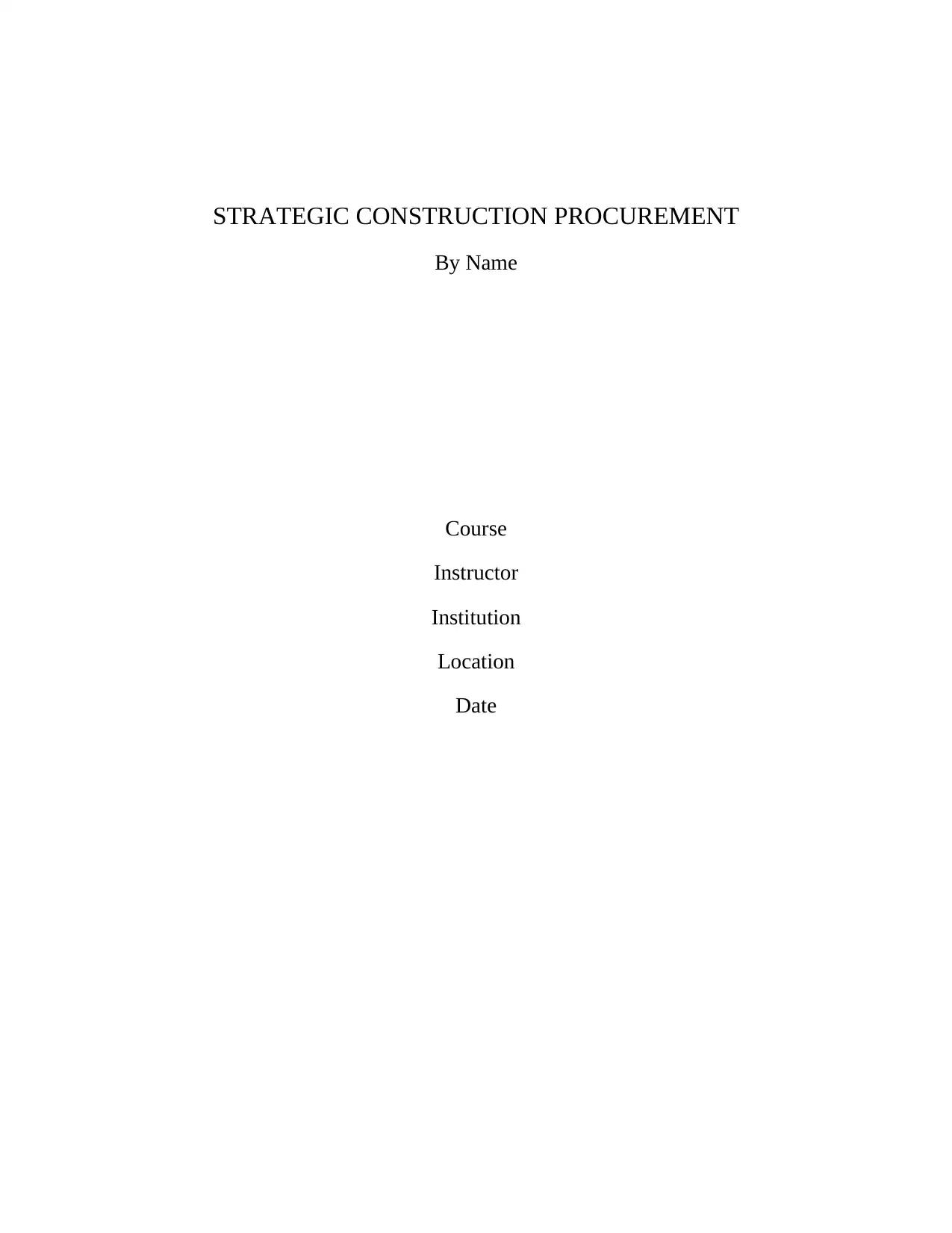
STRATEGIC CONSTRUCTION PROCUREMENT
By Name
Course
Instructor
Institution
Location
Date
By Name
Course
Instructor
Institution
Location
Date
Paraphrase This Document
Need a fresh take? Get an instant paraphrase of this document with our AI Paraphraser
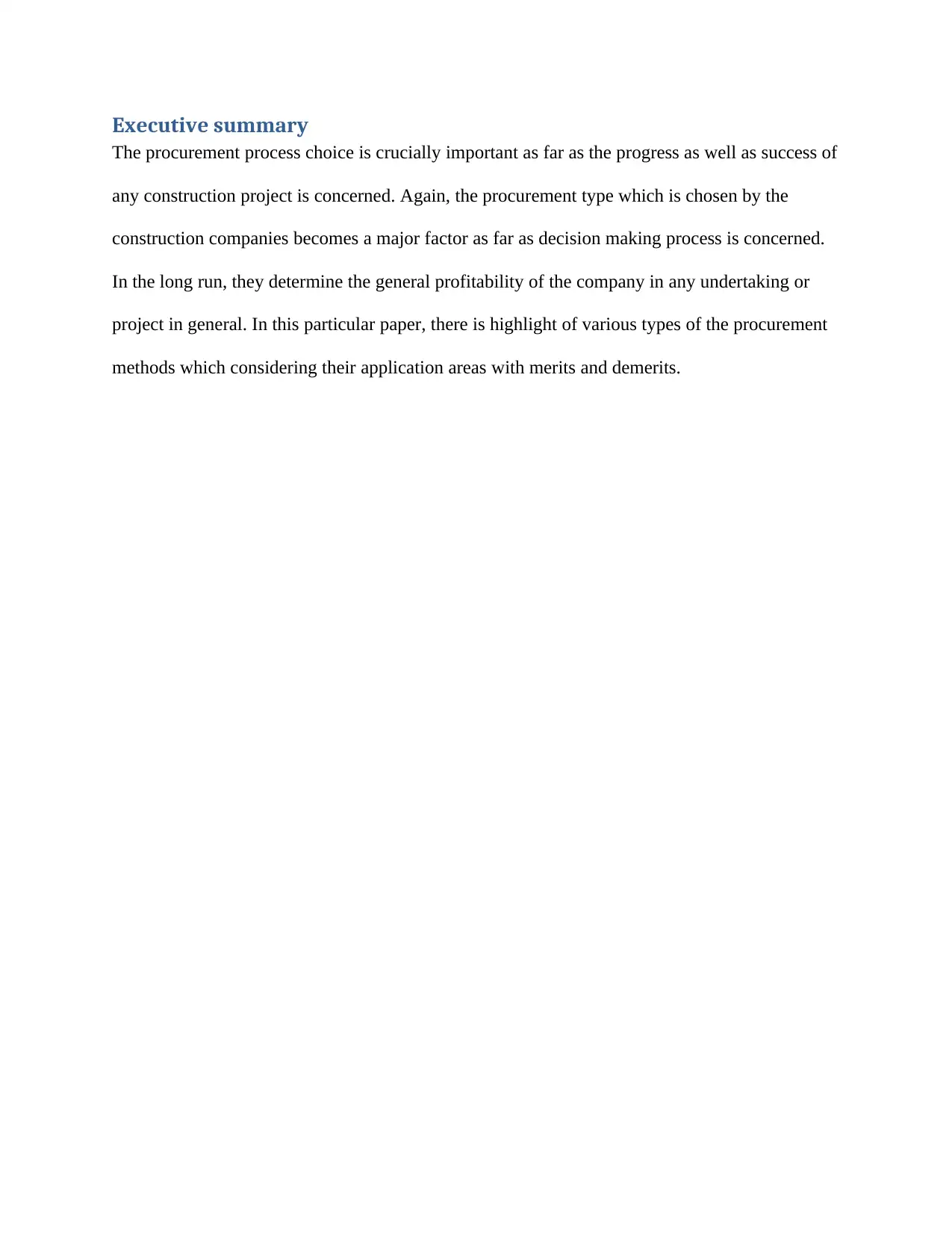
Executive summary
The procurement process choice is crucially important as far as the progress as well as success of
any construction project is concerned. Again, the procurement type which is chosen by the
construction companies becomes a major factor as far as decision making process is concerned.
In the long run, they determine the general profitability of the company in any undertaking or
project in general. In this particular paper, there is highlight of various types of the procurement
methods which considering their application areas with merits and demerits.
The procurement process choice is crucially important as far as the progress as well as success of
any construction project is concerned. Again, the procurement type which is chosen by the
construction companies becomes a major factor as far as decision making process is concerned.
In the long run, they determine the general profitability of the company in any undertaking or
project in general. In this particular paper, there is highlight of various types of the procurement
methods which considering their application areas with merits and demerits.
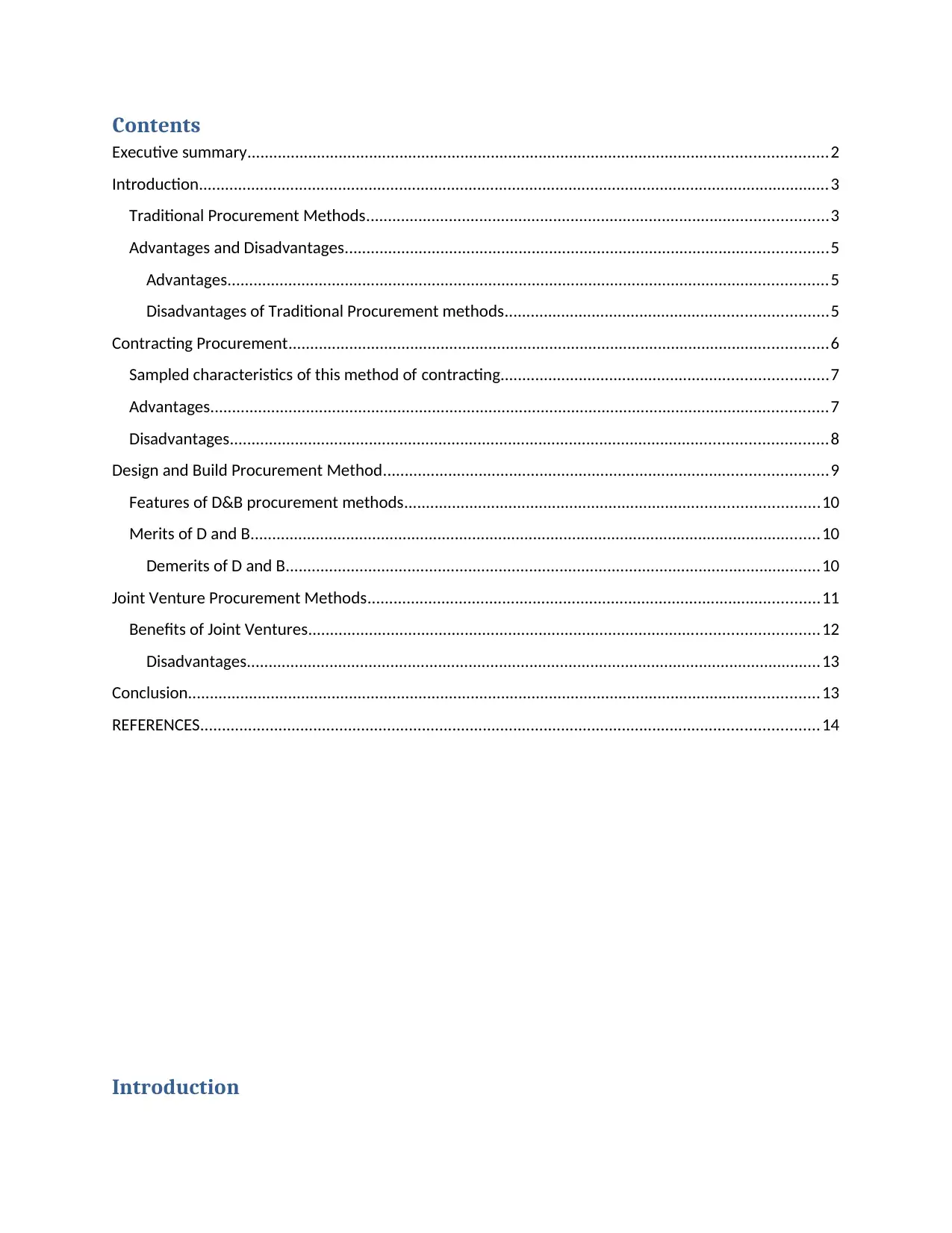
Contents
Executive summary.....................................................................................................................................2
Introduction.................................................................................................................................................3
Traditional Procurement Methods..........................................................................................................3
Advantages and Disadvantages...............................................................................................................5
Advantages..........................................................................................................................................5
Disadvantages of Traditional Procurement methods..........................................................................5
Contracting Procurement............................................................................................................................6
Sampled characteristics of this method of contracting...........................................................................7
Advantages..............................................................................................................................................7
Disadvantages.........................................................................................................................................8
Design and Build Procurement Method......................................................................................................9
Features of D&B procurement methods...............................................................................................10
Merits of D and B...................................................................................................................................10
Demerits of D and B...........................................................................................................................10
Joint Venture Procurement Methods........................................................................................................11
Benefits of Joint Ventures.....................................................................................................................12
Disadvantages....................................................................................................................................13
Conclusion.................................................................................................................................................13
REFERENCES..............................................................................................................................................14
Introduction
Executive summary.....................................................................................................................................2
Introduction.................................................................................................................................................3
Traditional Procurement Methods..........................................................................................................3
Advantages and Disadvantages...............................................................................................................5
Advantages..........................................................................................................................................5
Disadvantages of Traditional Procurement methods..........................................................................5
Contracting Procurement............................................................................................................................6
Sampled characteristics of this method of contracting...........................................................................7
Advantages..............................................................................................................................................7
Disadvantages.........................................................................................................................................8
Design and Build Procurement Method......................................................................................................9
Features of D&B procurement methods...............................................................................................10
Merits of D and B...................................................................................................................................10
Demerits of D and B...........................................................................................................................10
Joint Venture Procurement Methods........................................................................................................11
Benefits of Joint Ventures.....................................................................................................................12
Disadvantages....................................................................................................................................13
Conclusion.................................................................................................................................................13
REFERENCES..............................................................................................................................................14
Introduction
⊘ This is a preview!⊘
Do you want full access?
Subscribe today to unlock all pages.

Trusted by 1+ million students worldwide
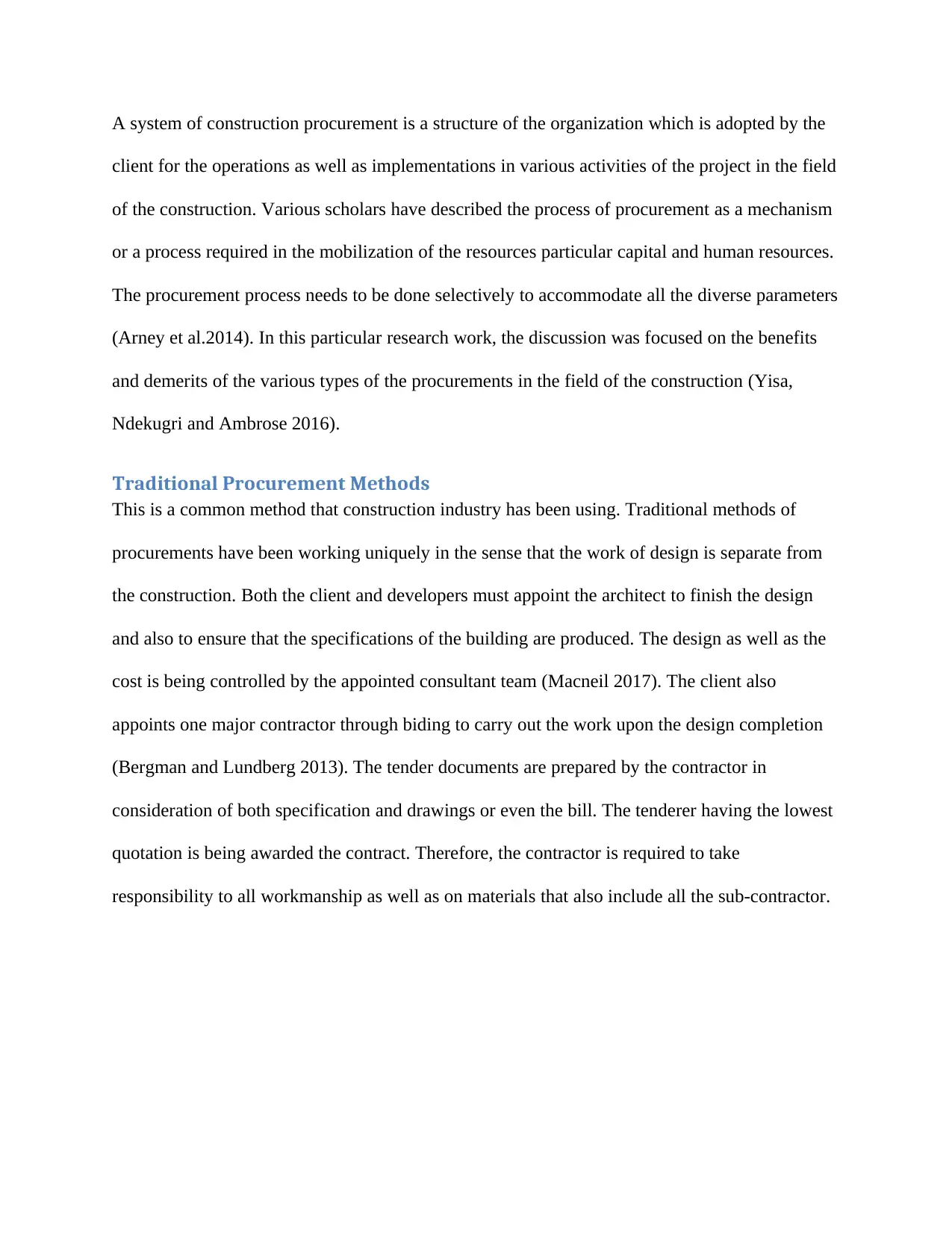
A system of construction procurement is a structure of the organization which is adopted by the
client for the operations as well as implementations in various activities of the project in the field
of the construction. Various scholars have described the process of procurement as a mechanism
or a process required in the mobilization of the resources particular capital and human resources.
The procurement process needs to be done selectively to accommodate all the diverse parameters
(Arney et al.2014). In this particular research work, the discussion was focused on the benefits
and demerits of the various types of the procurements in the field of the construction (Yisa,
Ndekugri and Ambrose 2016).
Traditional Procurement Methods
This is a common method that construction industry has been using. Traditional methods of
procurements have been working uniquely in the sense that the work of design is separate from
the construction. Both the client and developers must appoint the architect to finish the design
and also to ensure that the specifications of the building are produced. The design as well as the
cost is being controlled by the appointed consultant team (Macneil 2017). The client also
appoints one major contractor through biding to carry out the work upon the design completion
(Bergman and Lundberg 2013). The tender documents are prepared by the contractor in
consideration of both specification and drawings or even the bill. The tenderer having the lowest
quotation is being awarded the contract. Therefore, the contractor is required to take
responsibility to all workmanship as well as on materials that also include all the sub-contractor.
client for the operations as well as implementations in various activities of the project in the field
of the construction. Various scholars have described the process of procurement as a mechanism
or a process required in the mobilization of the resources particular capital and human resources.
The procurement process needs to be done selectively to accommodate all the diverse parameters
(Arney et al.2014). In this particular research work, the discussion was focused on the benefits
and demerits of the various types of the procurements in the field of the construction (Yisa,
Ndekugri and Ambrose 2016).
Traditional Procurement Methods
This is a common method that construction industry has been using. Traditional methods of
procurements have been working uniquely in the sense that the work of design is separate from
the construction. Both the client and developers must appoint the architect to finish the design
and also to ensure that the specifications of the building are produced. The design as well as the
cost is being controlled by the appointed consultant team (Macneil 2017). The client also
appoints one major contractor through biding to carry out the work upon the design completion
(Bergman and Lundberg 2013). The tender documents are prepared by the contractor in
consideration of both specification and drawings or even the bill. The tenderer having the lowest
quotation is being awarded the contract. Therefore, the contractor is required to take
responsibility to all workmanship as well as on materials that also include all the sub-contractor.
Paraphrase This Document
Need a fresh take? Get an instant paraphrase of this document with our AI Paraphraser
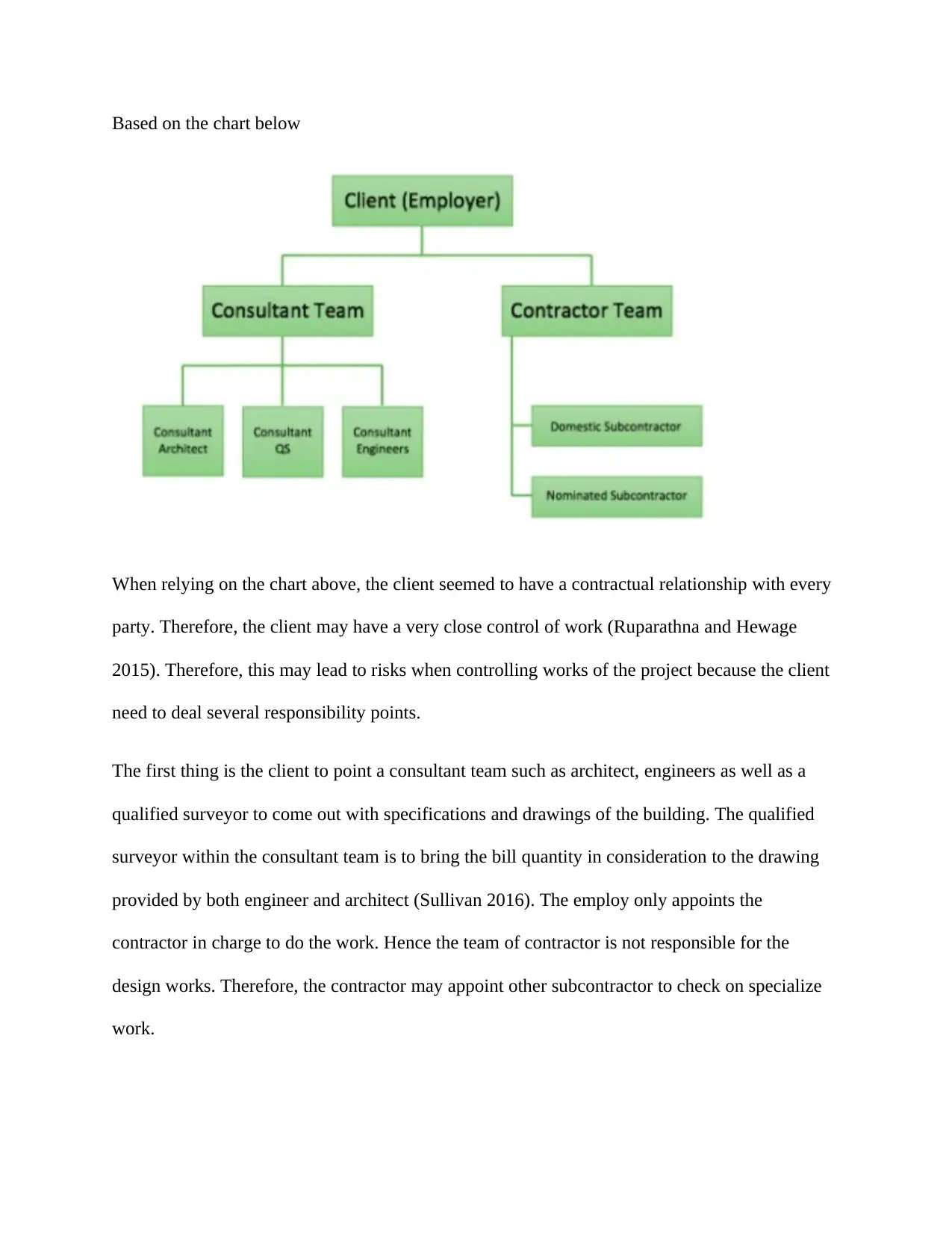
Based on the chart below
When relying on the chart above, the client seemed to have a contractual relationship with every
party. Therefore, the client may have a very close control of work (Ruparathna and Hewage
2015). Therefore, this may lead to risks when controlling works of the project because the client
need to deal several responsibility points.
The first thing is the client to point a consultant team such as architect, engineers as well as a
qualified surveyor to come out with specifications and drawings of the building. The qualified
surveyor within the consultant team is to bring the bill quantity in consideration to the drawing
provided by both engineer and architect (Sullivan 2016). The employ only appoints the
contractor in charge to do the work. Hence the team of contractor is not responsible for the
design works. Therefore, the contractor may appoint other subcontractor to check on specialize
work.
When relying on the chart above, the client seemed to have a contractual relationship with every
party. Therefore, the client may have a very close control of work (Ruparathna and Hewage
2015). Therefore, this may lead to risks when controlling works of the project because the client
need to deal several responsibility points.
The first thing is the client to point a consultant team such as architect, engineers as well as a
qualified surveyor to come out with specifications and drawings of the building. The qualified
surveyor within the consultant team is to bring the bill quantity in consideration to the drawing
provided by both engineer and architect (Sullivan 2016). The employ only appoints the
contractor in charge to do the work. Hence the team of contractor is not responsible for the
design works. Therefore, the contractor may appoint other subcontractor to check on specialize
work.
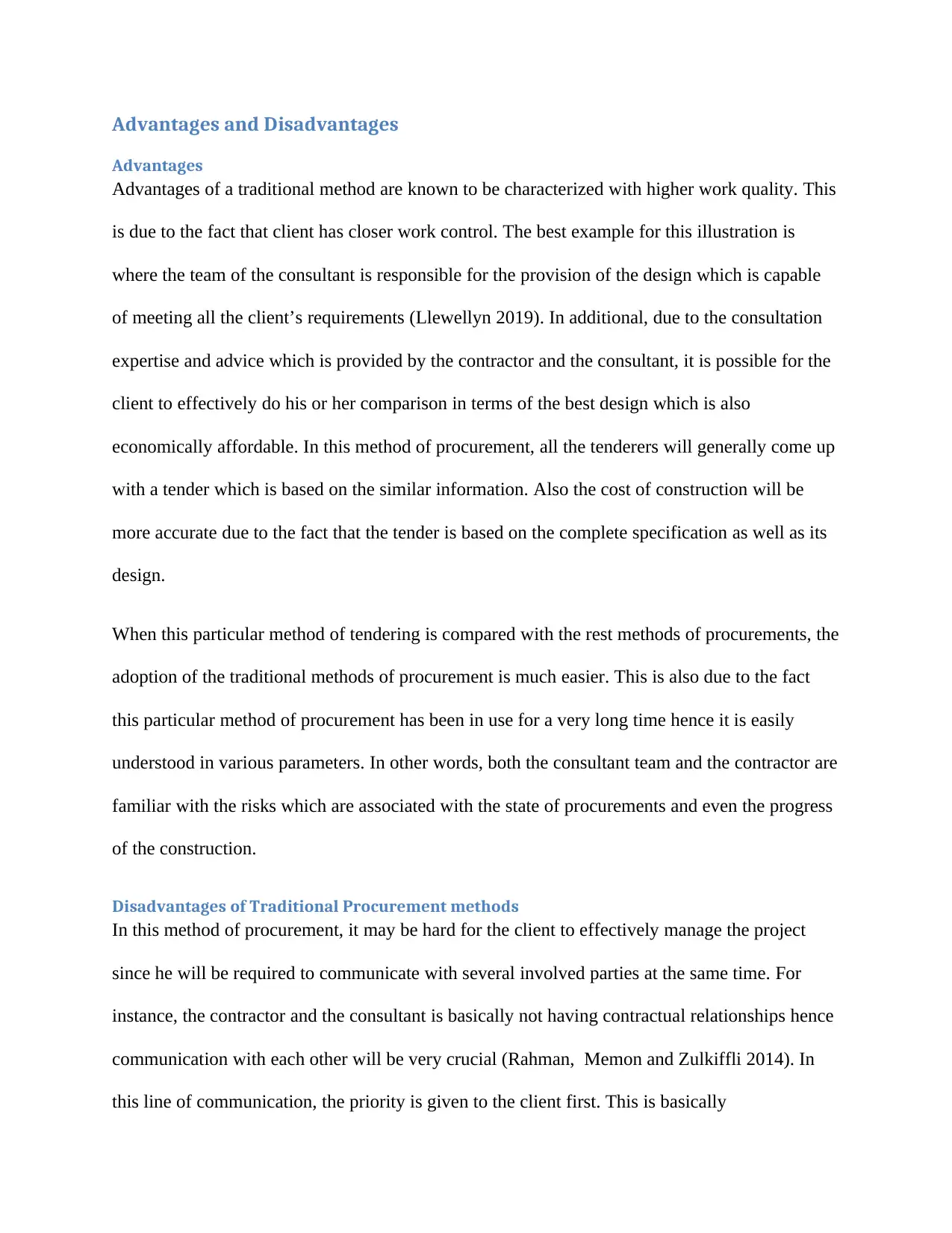
Advantages and Disadvantages
Advantages
Advantages of a traditional method are known to be characterized with higher work quality. This
is due to the fact that client has closer work control. The best example for this illustration is
where the team of the consultant is responsible for the provision of the design which is capable
of meeting all the client’s requirements (Llewellyn 2019). In additional, due to the consultation
expertise and advice which is provided by the contractor and the consultant, it is possible for the
client to effectively do his or her comparison in terms of the best design which is also
economically affordable. In this method of procurement, all the tenderers will generally come up
with a tender which is based on the similar information. Also the cost of construction will be
more accurate due to the fact that the tender is based on the complete specification as well as its
design.
When this particular method of tendering is compared with the rest methods of procurements, the
adoption of the traditional methods of procurement is much easier. This is also due to the fact
this particular method of procurement has been in use for a very long time hence it is easily
understood in various parameters. In other words, both the consultant team and the contractor are
familiar with the risks which are associated with the state of procurements and even the progress
of the construction.
Disadvantages of Traditional Procurement methods
In this method of procurement, it may be hard for the client to effectively manage the project
since he will be required to communicate with several involved parties at the same time. For
instance, the contractor and the consultant is basically not having contractual relationships hence
communication with each other will be very crucial (Rahman, Memon and Zulkiffli 2014). In
this line of communication, the priority is given to the client first. This is basically
Advantages
Advantages of a traditional method are known to be characterized with higher work quality. This
is due to the fact that client has closer work control. The best example for this illustration is
where the team of the consultant is responsible for the provision of the design which is capable
of meeting all the client’s requirements (Llewellyn 2019). In additional, due to the consultation
expertise and advice which is provided by the contractor and the consultant, it is possible for the
client to effectively do his or her comparison in terms of the best design which is also
economically affordable. In this method of procurement, all the tenderers will generally come up
with a tender which is based on the similar information. Also the cost of construction will be
more accurate due to the fact that the tender is based on the complete specification as well as its
design.
When this particular method of tendering is compared with the rest methods of procurements, the
adoption of the traditional methods of procurement is much easier. This is also due to the fact
this particular method of procurement has been in use for a very long time hence it is easily
understood in various parameters. In other words, both the consultant team and the contractor are
familiar with the risks which are associated with the state of procurements and even the progress
of the construction.
Disadvantages of Traditional Procurement methods
In this method of procurement, it may be hard for the client to effectively manage the project
since he will be required to communicate with several involved parties at the same time. For
instance, the contractor and the consultant is basically not having contractual relationships hence
communication with each other will be very crucial (Rahman, Memon and Zulkiffli 2014). In
this line of communication, the priority is given to the client first. This is basically
⊘ This is a preview!⊘
Do you want full access?
Subscribe today to unlock all pages.

Trusted by 1+ million students worldwide
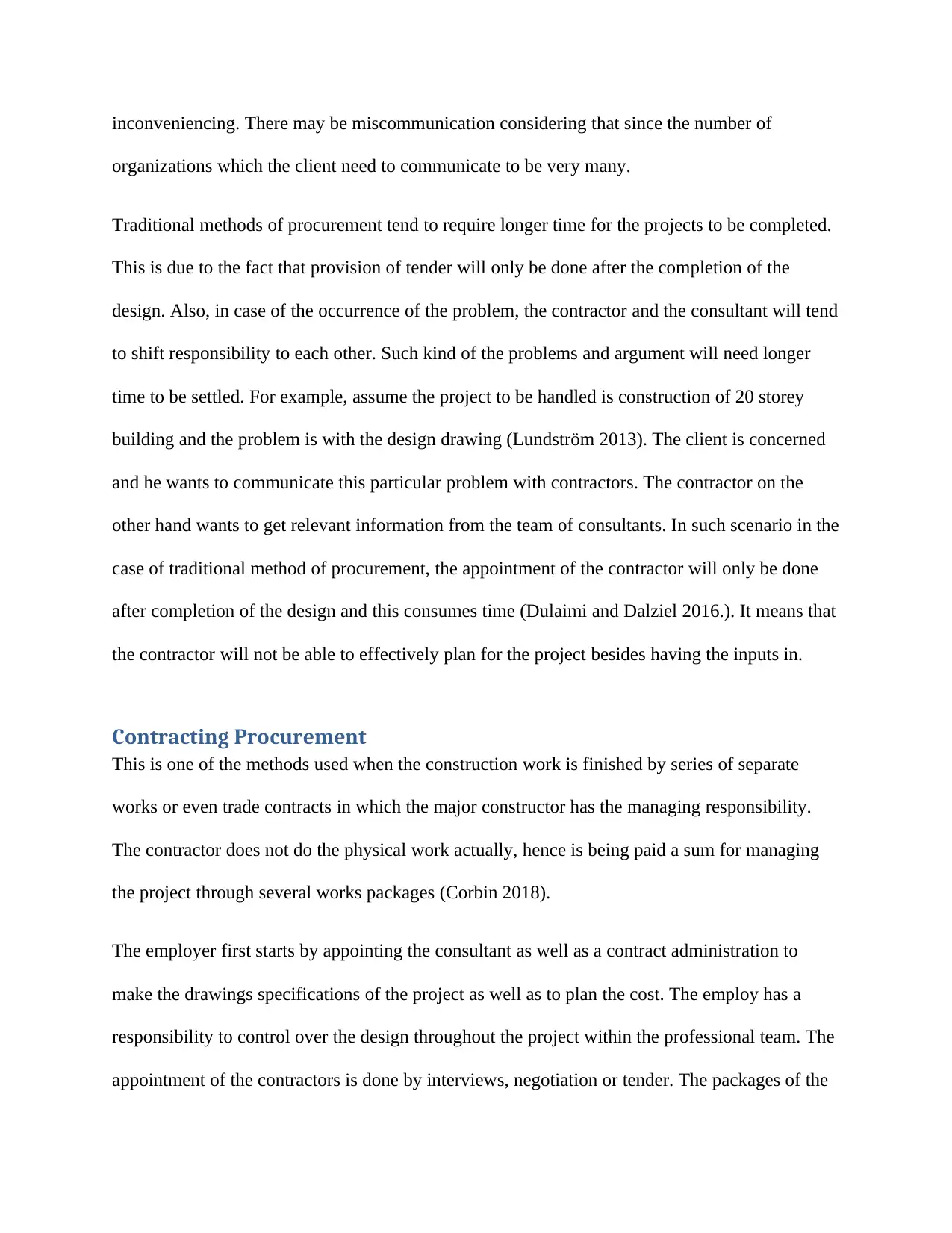
inconveniencing. There may be miscommunication considering that since the number of
organizations which the client need to communicate to be very many.
Traditional methods of procurement tend to require longer time for the projects to be completed.
This is due to the fact that provision of tender will only be done after the completion of the
design. Also, in case of the occurrence of the problem, the contractor and the consultant will tend
to shift responsibility to each other. Such kind of the problems and argument will need longer
time to be settled. For example, assume the project to be handled is construction of 20 storey
building and the problem is with the design drawing (Lundström 2013). The client is concerned
and he wants to communicate this particular problem with contractors. The contractor on the
other hand wants to get relevant information from the team of consultants. In such scenario in the
case of traditional method of procurement, the appointment of the contractor will only be done
after completion of the design and this consumes time (Dulaimi and Dalziel 2016.). It means that
the contractor will not be able to effectively plan for the project besides having the inputs in.
Contracting Procurement
This is one of the methods used when the construction work is finished by series of separate
works or even trade contracts in which the major constructor has the managing responsibility.
The contractor does not do the physical work actually, hence is being paid a sum for managing
the project through several works packages (Corbin 2018).
The employer first starts by appointing the consultant as well as a contract administration to
make the drawings specifications of the project as well as to plan the cost. The employ has a
responsibility to control over the design throughout the project within the professional team. The
appointment of the contractors is done by interviews, negotiation or tender. The packages of the
organizations which the client need to communicate to be very many.
Traditional methods of procurement tend to require longer time for the projects to be completed.
This is due to the fact that provision of tender will only be done after the completion of the
design. Also, in case of the occurrence of the problem, the contractor and the consultant will tend
to shift responsibility to each other. Such kind of the problems and argument will need longer
time to be settled. For example, assume the project to be handled is construction of 20 storey
building and the problem is with the design drawing (Lundström 2013). The client is concerned
and he wants to communicate this particular problem with contractors. The contractor on the
other hand wants to get relevant information from the team of consultants. In such scenario in the
case of traditional method of procurement, the appointment of the contractor will only be done
after completion of the design and this consumes time (Dulaimi and Dalziel 2016.). It means that
the contractor will not be able to effectively plan for the project besides having the inputs in.
Contracting Procurement
This is one of the methods used when the construction work is finished by series of separate
works or even trade contracts in which the major constructor has the managing responsibility.
The contractor does not do the physical work actually, hence is being paid a sum for managing
the project through several works packages (Corbin 2018).
The employer first starts by appointing the consultant as well as a contract administration to
make the drawings specifications of the project as well as to plan the cost. The employ has a
responsibility to control over the design throughout the project within the professional team. The
appointment of the contractors is done by interviews, negotiation or tender. The packages of the
Paraphrase This Document
Need a fresh take? Get an instant paraphrase of this document with our AI Paraphraser
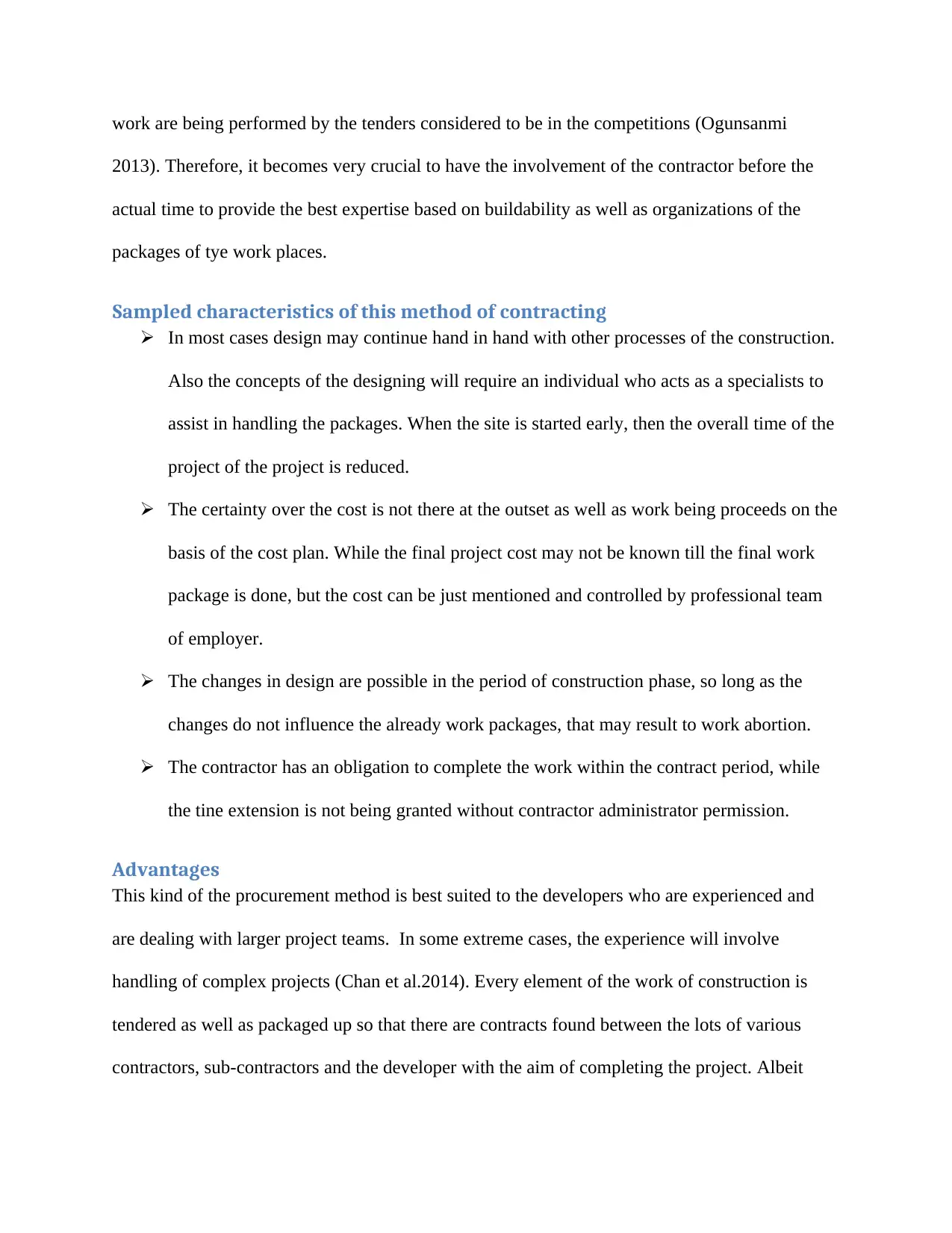
work are being performed by the tenders considered to be in the competitions (Ogunsanmi
2013). Therefore, it becomes very crucial to have the involvement of the contractor before the
actual time to provide the best expertise based on buildability as well as organizations of the
packages of tye work places.
Sampled characteristics of this method of contracting
In most cases design may continue hand in hand with other processes of the construction.
Also the concepts of the designing will require an individual who acts as a specialists to
assist in handling the packages. When the site is started early, then the overall time of the
project of the project is reduced.
The certainty over the cost is not there at the outset as well as work being proceeds on the
basis of the cost plan. While the final project cost may not be known till the final work
package is done, but the cost can be just mentioned and controlled by professional team
of employer.
The changes in design are possible in the period of construction phase, so long as the
changes do not influence the already work packages, that may result to work abortion.
The contractor has an obligation to complete the work within the contract period, while
the tine extension is not being granted without contractor administrator permission.
Advantages
This kind of the procurement method is best suited to the developers who are experienced and
are dealing with larger project teams. In some extreme cases, the experience will involve
handling of complex projects (Chan et al.2014). Every element of the work of construction is
tendered as well as packaged up so that there are contracts found between the lots of various
contractors, sub-contractors and the developer with the aim of completing the project. Albeit
2013). Therefore, it becomes very crucial to have the involvement of the contractor before the
actual time to provide the best expertise based on buildability as well as organizations of the
packages of tye work places.
Sampled characteristics of this method of contracting
In most cases design may continue hand in hand with other processes of the construction.
Also the concepts of the designing will require an individual who acts as a specialists to
assist in handling the packages. When the site is started early, then the overall time of the
project of the project is reduced.
The certainty over the cost is not there at the outset as well as work being proceeds on the
basis of the cost plan. While the final project cost may not be known till the final work
package is done, but the cost can be just mentioned and controlled by professional team
of employer.
The changes in design are possible in the period of construction phase, so long as the
changes do not influence the already work packages, that may result to work abortion.
The contractor has an obligation to complete the work within the contract period, while
the tine extension is not being granted without contractor administrator permission.
Advantages
This kind of the procurement method is best suited to the developers who are experienced and
are dealing with larger project teams. In some extreme cases, the experience will involve
handling of complex projects (Chan et al.2014). Every element of the work of construction is
tendered as well as packaged up so that there are contracts found between the lots of various
contractors, sub-contractors and the developer with the aim of completing the project. Albeit
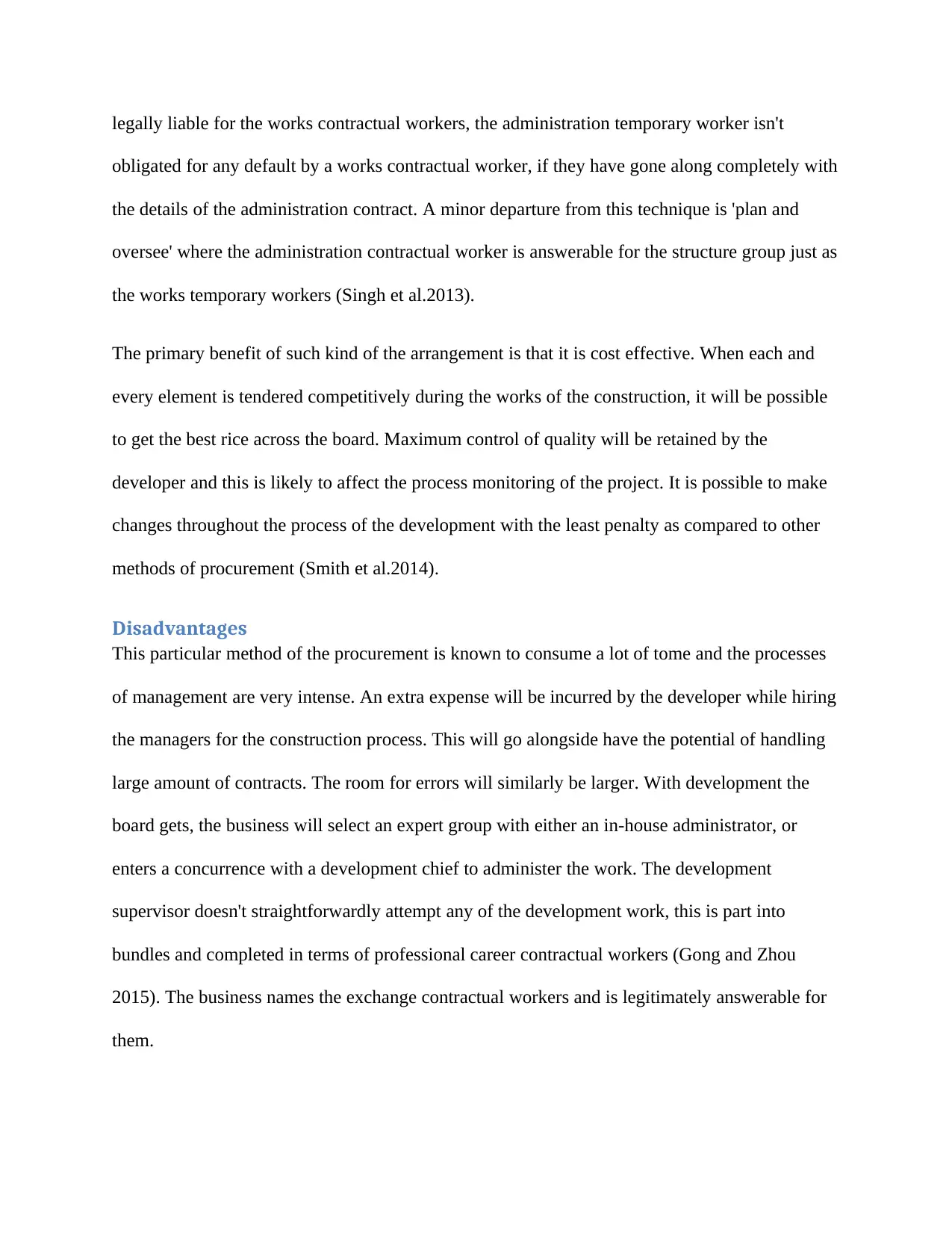
legally liable for the works contractual workers, the administration temporary worker isn't
obligated for any default by a works contractual worker, if they have gone along completely with
the details of the administration contract. A minor departure from this technique is 'plan and
oversee' where the administration contractual worker is answerable for the structure group just as
the works temporary workers (Singh et al.2013).
The primary benefit of such kind of the arrangement is that it is cost effective. When each and
every element is tendered competitively during the works of the construction, it will be possible
to get the best rice across the board. Maximum control of quality will be retained by the
developer and this is likely to affect the process monitoring of the project. It is possible to make
changes throughout the process of the development with the least penalty as compared to other
methods of procurement (Smith et al.2014).
Disadvantages
This particular method of the procurement is known to consume a lot of tome and the processes
of management are very intense. An extra expense will be incurred by the developer while hiring
the managers for the construction process. This will go alongside have the potential of handling
large amount of contracts. The room for errors will similarly be larger. With development the
board gets, the business will select an expert group with either an in-house administrator, or
enters a concurrence with a development chief to administer the work. The development
supervisor doesn't straightforwardly attempt any of the development work, this is part into
bundles and completed in terms of professional career contractual workers (Gong and Zhou
2015). The business names the exchange contractual workers and is legitimately answerable for
them.
obligated for any default by a works contractual worker, if they have gone along completely with
the details of the administration contract. A minor departure from this technique is 'plan and
oversee' where the administration contractual worker is answerable for the structure group just as
the works temporary workers (Singh et al.2013).
The primary benefit of such kind of the arrangement is that it is cost effective. When each and
every element is tendered competitively during the works of the construction, it will be possible
to get the best rice across the board. Maximum control of quality will be retained by the
developer and this is likely to affect the process monitoring of the project. It is possible to make
changes throughout the process of the development with the least penalty as compared to other
methods of procurement (Smith et al.2014).
Disadvantages
This particular method of the procurement is known to consume a lot of tome and the processes
of management are very intense. An extra expense will be incurred by the developer while hiring
the managers for the construction process. This will go alongside have the potential of handling
large amount of contracts. The room for errors will similarly be larger. With development the
board gets, the business will select an expert group with either an in-house administrator, or
enters a concurrence with a development chief to administer the work. The development
supervisor doesn't straightforwardly attempt any of the development work, this is part into
bundles and completed in terms of professional career contractual workers (Gong and Zhou
2015). The business names the exchange contractual workers and is legitimately answerable for
them.
⊘ This is a preview!⊘
Do you want full access?
Subscribe today to unlock all pages.

Trusted by 1+ million students worldwide
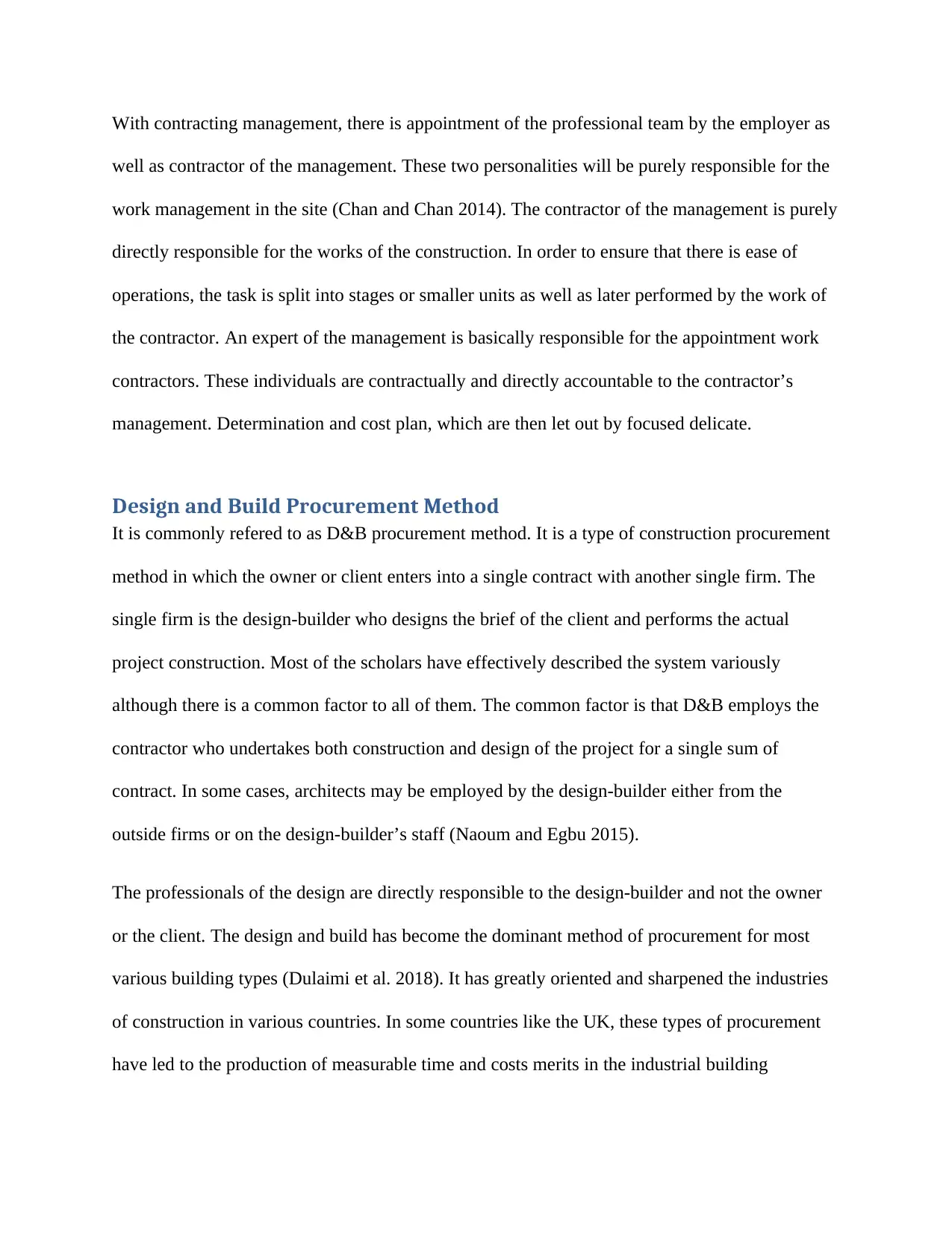
With contracting management, there is appointment of the professional team by the employer as
well as contractor of the management. These two personalities will be purely responsible for the
work management in the site (Chan and Chan 2014). The contractor of the management is purely
directly responsible for the works of the construction. In order to ensure that there is ease of
operations, the task is split into stages or smaller units as well as later performed by the work of
the contractor. An expert of the management is basically responsible for the appointment work
contractors. These individuals are contractually and directly accountable to the contractor’s
management. Determination and cost plan, which are then let out by focused delicate.
Design and Build Procurement Method
It is commonly refered to as D&B procurement method. It is a type of construction procurement
method in which the owner or client enters into a single contract with another single firm. The
single firm is the design-builder who designs the brief of the client and performs the actual
project construction. Most of the scholars have effectively described the system variously
although there is a common factor to all of them. The common factor is that D&B employs the
contractor who undertakes both construction and design of the project for a single sum of
contract. In some cases, architects may be employed by the design-builder either from the
outside firms or on the design-builder’s staff (Naoum and Egbu 2015).
The professionals of the design are directly responsible to the design-builder and not the owner
or the client. The design and build has become the dominant method of procurement for most
various building types (Dulaimi et al. 2018). It has greatly oriented and sharpened the industries
of construction in various countries. In some countries like the UK, these types of procurement
have led to the production of measurable time and costs merits in the industrial building
well as contractor of the management. These two personalities will be purely responsible for the
work management in the site (Chan and Chan 2014). The contractor of the management is purely
directly responsible for the works of the construction. In order to ensure that there is ease of
operations, the task is split into stages or smaller units as well as later performed by the work of
the contractor. An expert of the management is basically responsible for the appointment work
contractors. These individuals are contractually and directly accountable to the contractor’s
management. Determination and cost plan, which are then let out by focused delicate.
Design and Build Procurement Method
It is commonly refered to as D&B procurement method. It is a type of construction procurement
method in which the owner or client enters into a single contract with another single firm. The
single firm is the design-builder who designs the brief of the client and performs the actual
project construction. Most of the scholars have effectively described the system variously
although there is a common factor to all of them. The common factor is that D&B employs the
contractor who undertakes both construction and design of the project for a single sum of
contract. In some cases, architects may be employed by the design-builder either from the
outside firms or on the design-builder’s staff (Naoum and Egbu 2015).
The professionals of the design are directly responsible to the design-builder and not the owner
or the client. The design and build has become the dominant method of procurement for most
various building types (Dulaimi et al. 2018). It has greatly oriented and sharpened the industries
of construction in various countries. In some countries like the UK, these types of procurement
have led to the production of measurable time and costs merits in the industrial building
Paraphrase This Document
Need a fresh take? Get an instant paraphrase of this document with our AI Paraphraser
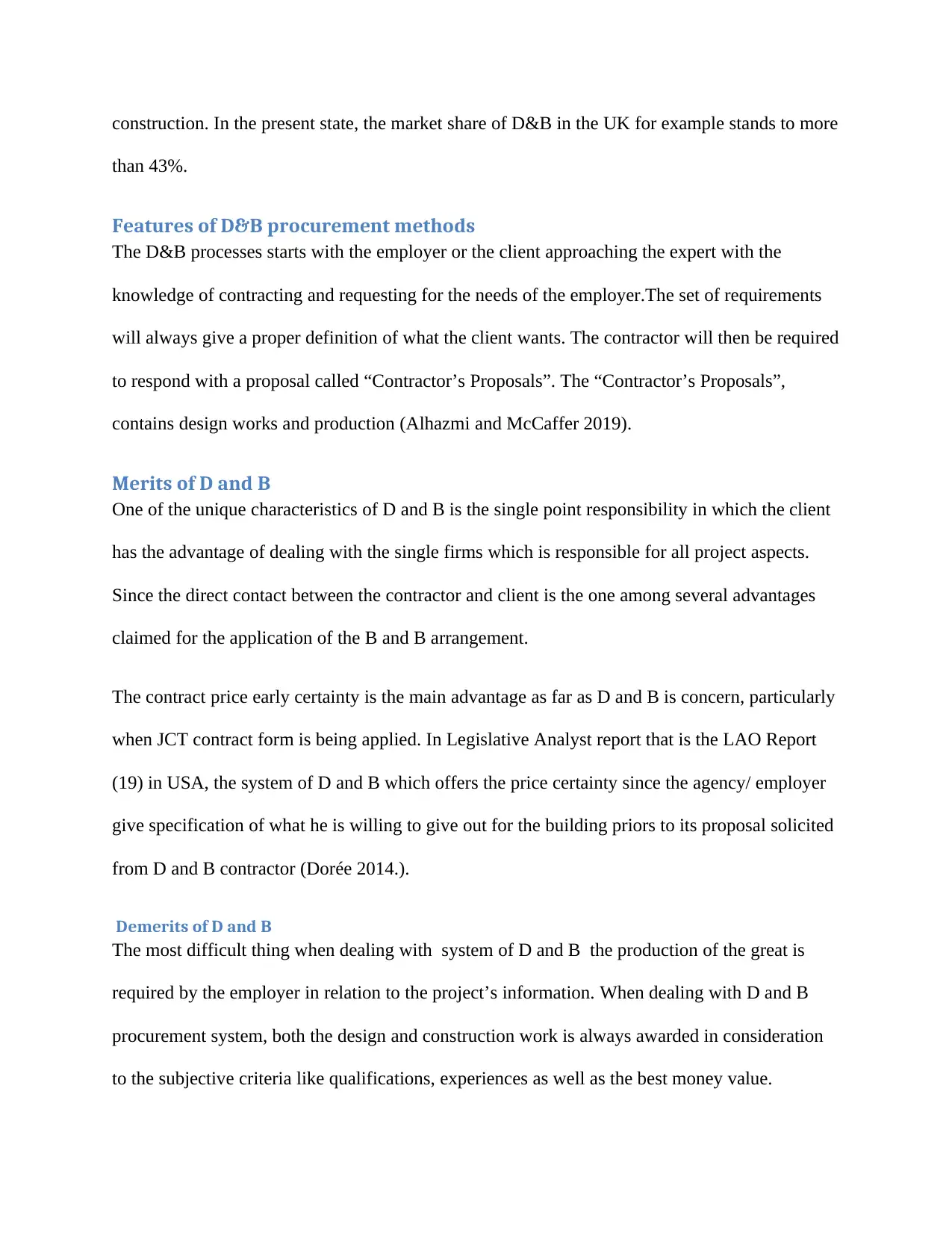
construction. In the present state, the market share of D&B in the UK for example stands to more
than 43%.
Features of D&B procurement methods
The D&B processes starts with the employer or the client approaching the expert with the
knowledge of contracting and requesting for the needs of the employer.The set of requirements
will always give a proper definition of what the client wants. The contractor will then be required
to respond with a proposal called “Contractor’s Proposals”. The “Contractor’s Proposals”,
contains design works and production (Alhazmi and McCaffer 2019).
Merits of D and B
One of the unique characteristics of D and B is the single point responsibility in which the client
has the advantage of dealing with the single firms which is responsible for all project aspects.
Since the direct contact between the contractor and client is the one among several advantages
claimed for the application of the B and B arrangement.
The contract price early certainty is the main advantage as far as D and B is concern, particularly
when JCT contract form is being applied. In Legislative Analyst report that is the LAO Report
(19) in USA, the system of D and B which offers the price certainty since the agency/ employer
give specification of what he is willing to give out for the building priors to its proposal solicited
from D and B contractor (Dorée 2014.).
Demerits of D and B
The most difficult thing when dealing with system of D and B the production of the great is
required by the employer in relation to the project’s information. When dealing with D and B
procurement system, both the design and construction work is always awarded in consideration
to the subjective criteria like qualifications, experiences as well as the best money value.
than 43%.
Features of D&B procurement methods
The D&B processes starts with the employer or the client approaching the expert with the
knowledge of contracting and requesting for the needs of the employer.The set of requirements
will always give a proper definition of what the client wants. The contractor will then be required
to respond with a proposal called “Contractor’s Proposals”. The “Contractor’s Proposals”,
contains design works and production (Alhazmi and McCaffer 2019).
Merits of D and B
One of the unique characteristics of D and B is the single point responsibility in which the client
has the advantage of dealing with the single firms which is responsible for all project aspects.
Since the direct contact between the contractor and client is the one among several advantages
claimed for the application of the B and B arrangement.
The contract price early certainty is the main advantage as far as D and B is concern, particularly
when JCT contract form is being applied. In Legislative Analyst report that is the LAO Report
(19) in USA, the system of D and B which offers the price certainty since the agency/ employer
give specification of what he is willing to give out for the building priors to its proposal solicited
from D and B contractor (Dorée 2014.).
Demerits of D and B
The most difficult thing when dealing with system of D and B the production of the great is
required by the employer in relation to the project’s information. When dealing with D and B
procurement system, both the design and construction work is always awarded in consideration
to the subjective criteria like qualifications, experiences as well as the best money value.
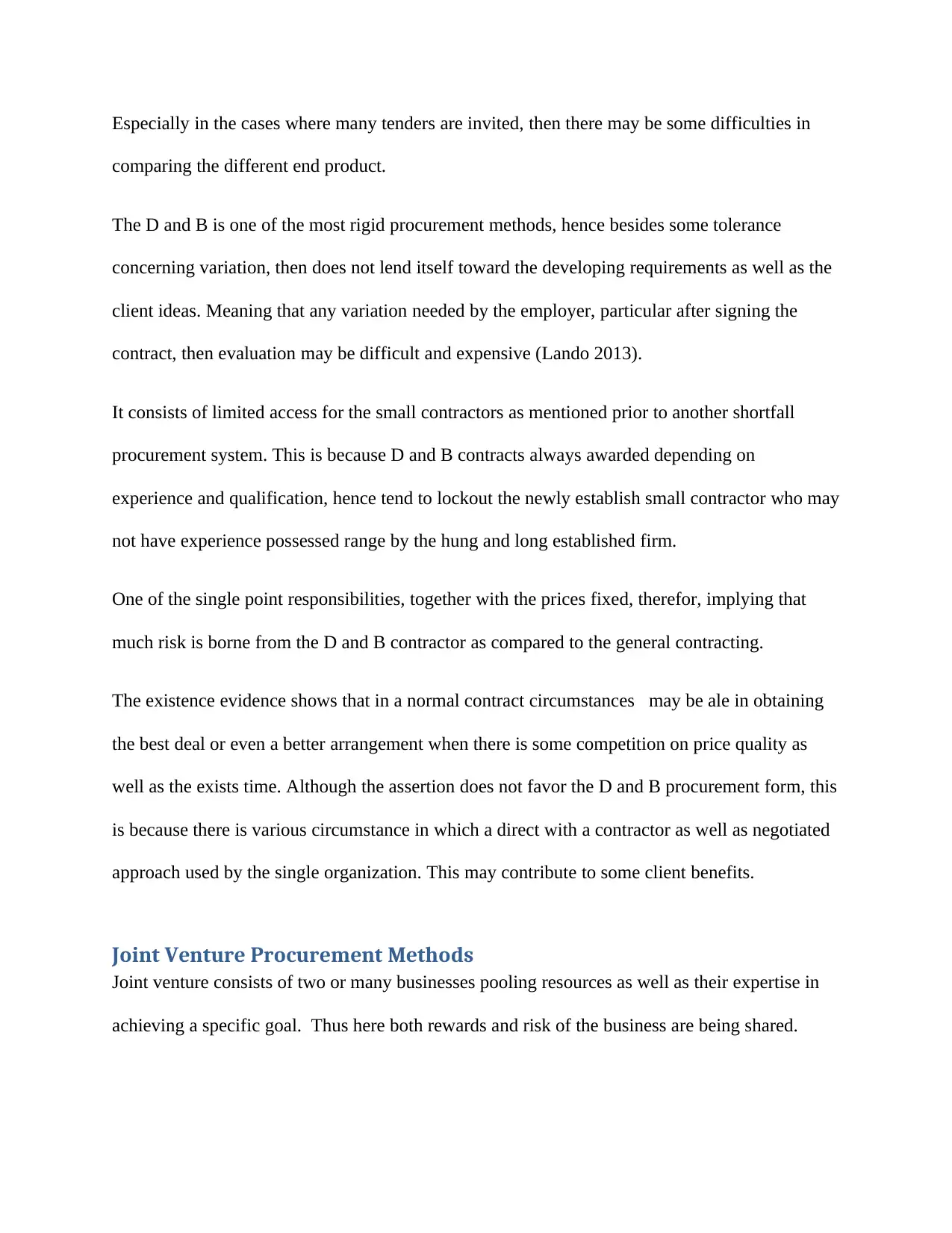
Especially in the cases where many tenders are invited, then there may be some difficulties in
comparing the different end product.
The D and B is one of the most rigid procurement methods, hence besides some tolerance
concerning variation, then does not lend itself toward the developing requirements as well as the
client ideas. Meaning that any variation needed by the employer, particular after signing the
contract, then evaluation may be difficult and expensive (Lando 2013).
It consists of limited access for the small contractors as mentioned prior to another shortfall
procurement system. This is because D and B contracts always awarded depending on
experience and qualification, hence tend to lockout the newly establish small contractor who may
not have experience possessed range by the hung and long established firm.
One of the single point responsibilities, together with the prices fixed, therefor, implying that
much risk is borne from the D and B contractor as compared to the general contracting.
The existence evidence shows that in a normal contract circumstances may be ale in obtaining
the best deal or even a better arrangement when there is some competition on price quality as
well as the exists time. Although the assertion does not favor the D and B procurement form, this
is because there is various circumstance in which a direct with a contractor as well as negotiated
approach used by the single organization. This may contribute to some client benefits.
Joint Venture Procurement Methods
Joint venture consists of two or many businesses pooling resources as well as their expertise in
achieving a specific goal. Thus here both rewards and risk of the business are being shared.
comparing the different end product.
The D and B is one of the most rigid procurement methods, hence besides some tolerance
concerning variation, then does not lend itself toward the developing requirements as well as the
client ideas. Meaning that any variation needed by the employer, particular after signing the
contract, then evaluation may be difficult and expensive (Lando 2013).
It consists of limited access for the small contractors as mentioned prior to another shortfall
procurement system. This is because D and B contracts always awarded depending on
experience and qualification, hence tend to lockout the newly establish small contractor who may
not have experience possessed range by the hung and long established firm.
One of the single point responsibilities, together with the prices fixed, therefor, implying that
much risk is borne from the D and B contractor as compared to the general contracting.
The existence evidence shows that in a normal contract circumstances may be ale in obtaining
the best deal or even a better arrangement when there is some competition on price quality as
well as the exists time. Although the assertion does not favor the D and B procurement form, this
is because there is various circumstance in which a direct with a contractor as well as negotiated
approach used by the single organization. This may contribute to some client benefits.
Joint Venture Procurement Methods
Joint venture consists of two or many businesses pooling resources as well as their expertise in
achieving a specific goal. Thus here both rewards and risk of the business are being shared.
⊘ This is a preview!⊘
Do you want full access?
Subscribe today to unlock all pages.

Trusted by 1+ million students worldwide
1 out of 17
Related Documents
Your All-in-One AI-Powered Toolkit for Academic Success.
+13062052269
info@desklib.com
Available 24*7 on WhatsApp / Email
![[object Object]](/_next/static/media/star-bottom.7253800d.svg)
Unlock your academic potential
Copyright © 2020–2025 A2Z Services. All Rights Reserved. Developed and managed by ZUCOL.





